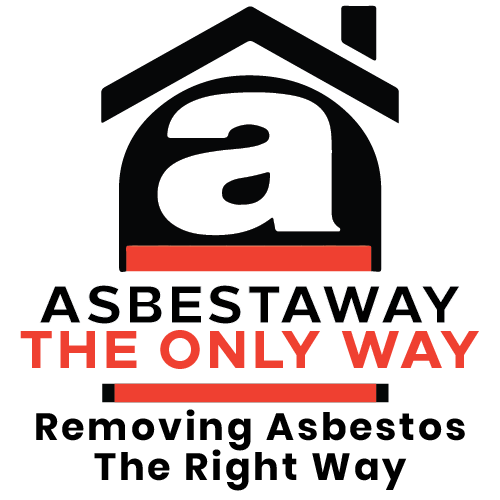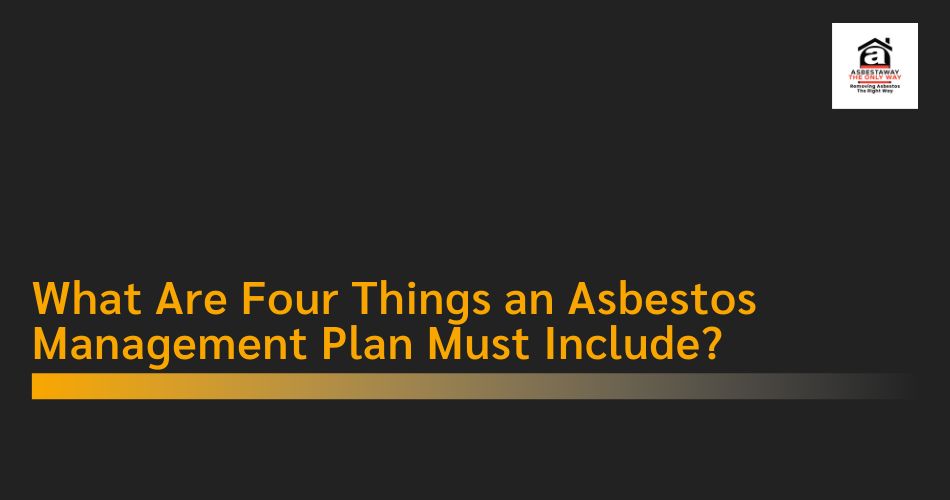Asbestos, once widely used for its fire-resistant and insulating properties, is now recognized as a hazardous material that can cause serious health issues, including mesothelioma, asbestosis, and lung cancer. Due to its potential dangers, any property that contains asbestos must have a clear and effective asbestos management plan (AMP) in place.
An asbestos management plan is a critical document that outlines the procedures for identifying, handling, monitoring, and controlling asbestos risks within a building or facility. Whether you’re a property owner, employer, or facility manager, understanding the components of an effective AMP is essential for ensuring the safety of everyone in and around the building.
In this blog, we will explore the four key elements that must be included in an asbestos management plan and the role that companies like Asbestaway play in helping to implement these strategies effectively.
What Is an Asbestos Management Plan?
An Asbestos Management Plan is a written document that provides detailed instructions on how asbestos-containing materials (ACMs) in a building should be managed, monitored, and controlled. The goal of the plan is to protect workers, tenants, and visitors from exposure to asbestos fibers.
The management of asbestos is an ongoing process that includes identifying materials that may contain asbestos, assessing their condition, and monitoring the risks. This plan ensures that the proper procedures are followed for the safe handling of ACMs and that compliance with relevant health and safety regulations is maintained.
In many regions, regulations require that an AMP be created for any workplace or public building that contains asbestos. It is a proactive measure to prevent exposure to hazardous asbestos fibers, especially during renovations, repairs, or demolition.
Four Key Elements Every Asbestos Management Plan Must Include
There are several critical components that must be included in an asbestos management plan to ensure that it is comprehensive, effective, and compliant with legal standards. Below are the four fundamental elements every asbestos management plan must address:
1. Identification of Asbestos-Containing Materials (ACMs)
The first and most important step in creating an asbestos management plan is to identify all asbestos-containing materials within the building or facility. Without knowing where the asbestos is, it is impossible to manage the risks associated with it.
Identification involves:
-
Conducting a Survey: A thorough survey of the building needs to be carried out by a trained and licensed asbestos professional. This includes both visible and hidden materials that may contain asbestos, such as insulation, flooring, ceiling tiles, roofing materials, and pipe lagging.
-
Material Assessment: Once asbestos-containing materials have been identified, they must be assessed for their condition. Materials in good condition may pose a minimal risk, while damaged or deteriorating materials may require immediate attention.
-
Inventory of ACMs: An inventory must be created that includes the location, type, and quantity of each asbestos-containing material in the building. This inventory is crucial for planning future inspections and ensuring that proper precautions are taken.
Having an up-to-date, accurate record of all asbestos-containing materials is the foundation of any successful asbestos management plan. This inventory should be reviewed regularly and updated if new materials are discovered or if the condition of existing ACMs changes.
2. Risk Assessment and Management
Once ACMs have been identified, the next step is to assess the risk they pose to health and safety. Risk assessments must take into account the condition of the materials, the level of exposure, and the likelihood of asbestos fibers being released into the air. A risk assessment is a key component of the asbestos management plan because it helps determine what actions are needed to control or mitigate the risks.
Risk assessment involves:
-
Evaluating the Condition of ACMs: Asbestos materials that are intact and undisturbed present a lower risk than materials that are damaged, degraded, or located in high-traffic areas. Materials in poor condition may release fibers into the air when disturbed, which increases the risk of exposure.
-
Exposure Pathways: Identifying how and where asbestos fibers could be disturbed is critical. For instance, work areas, maintenance activities, or renovations can increase the likelihood of exposure. High-risk areas should be marked and restricted to ensure that workers or occupants do not accidentally disturb the materials.
-
Prioritization of Action: Based on the risk assessment, the asbestos management plan should outline specific actions to be taken to reduce or eliminate exposure. Low-risk materials may require only regular monitoring, while higher-risk materials may need to be removed or repaired.
The goal of the risk assessment is to make sure that the building is safe for occupants and workers by preventing the release of asbestos fibers into the air. Proper risk management ensures that workers and other individuals are not exposed to asbestos hazards.
3. Control Measures and Procedures
The next key element of an asbestos management plan is establishing control measures and procedures for managing ACMs. These measures are designed to prevent exposure to asbestos fibers and minimize the risk of contamination. Control procedures will depend on the condition of the asbestos-containing materials, the risk of disturbance, and the level of exposure.
Control measures typically include:
-
Encapsulation: If ACMs are in good condition but in locations where they could be disturbed, encapsulation may be used. This process involves sealing the asbestos material with a protective coating to prevent fibers from being released into the air.
-
Enclosure: In some cases, asbestos-containing materials may need to be enclosed to prevent access or contact. For example, pipe insulation may be encased in a sealed, airtight barrier to limit the exposure to asbestos fibers.
-
Safe Work Practices: For areas where maintenance or work may disturb ACMs, specific work practices and protective equipment should be outlined. This includes using wetting agents to keep asbestos fibers from becoming airborne, providing personal protective equipment (PPE), and ensuring workers are trained in safe asbestos handling.
-
Monitoring and Air Quality Control: If asbestos removal or maintenance is scheduled, air quality monitoring should be part of the plan. This includes using air sampling devices to check for asbestos fibers in the air and ensure the area is safe before it is reopened for use.
-
Training and Awareness: One of the most critical elements of any asbestos management plan is ensuring that workers and employees are trained and aware of the potential risks. The plan should include a training program that educates workers on the dangers of asbestos, how to recognize ACMs, and the appropriate safety measures to take when working around them.
The asbestos management plan should ensure that these control measures are implemented and followed consistently to minimize the risk of exposure to harmful asbestos fibers.
4. Monitoring and Review of the Asbestos Management Plan
An asbestos management plan is not a one-time document; it requires ongoing monitoring and review to ensure its continued effectiveness. Regular inspections and updates are crucial to managing any changes that may occur over time, such as the deterioration of ACMs, new construction, or changes in work practices.
Monitoring and review include:
-
Routine Inspections: Regular inspections of ACMs should be conducted to assess their condition and identify any signs of wear, damage, or degradation. Inspections may be scheduled annually, or more frequently if necessary, depending on the level of risk and the condition of the materials.
-
Record-Keeping and Documentation: The asbestos management plan should include a system for tracking all inspections, repairs, and actions taken. This helps to maintain an up-to-date record and ensures compliance with legal requirements.
-
Review and Updates: The plan should be reviewed and updated regularly to account for any changes in the building or facility, such as renovations, repairs, or new asbestos discoveries. If new ACMs are identified or the condition of existing materials changes, the management plan should be revised to reflect these changes.
By keeping the plan updated and regularly reviewing it, property owners and managers can ensure that they are always in compliance with safety regulations and that asbestos risks are being effectively managed.
The Role of Asbestaway in Implementing an Asbestos Management Plan
Asbestaway, an Australian-based company, plays a vital role in helping businesses and property owners implement comprehensive asbestos management plans. Their services include:
-
Asbestos Testing and Surveying: Asbestaway offers thorough asbestos testing and surveying services to identify and assess the condition of ACMs in your property. Their team can conduct a detailed inspection and provide recommendations on how to manage any risks associated with asbestos.
-
Risk Assessment and Action Plans: After identifying asbestos materials, Asbestaway assists with risk assessments to evaluate the level of risk and determine appropriate control measures. They help prioritize actions and establish an action plan tailored to the specific needs of your property.
-
Asbestos Removal and Encapsulation: Asbestaway specializes in the safe removal and encapsulation of asbestos materials. Whether it involves full-scale removal or containment to prevent further exposure, Asbestaway ensures that the process follows all safety regulations and guidelines.
-
Ongoing Monitoring and Maintenance: As part of an effective asbestos management plan, Asbestaway provides ongoing monitoring services to track the condition of any remaining ACMs and ensure the plan remains up to date. This includes regular inspections and air quality testing to confirm that the building remains safe.
Conclusion
An asbestos management plan is a crucial tool for ensuring the safety of building occupants and workers when asbestos-containing materials are present. The plan should include clear identification of ACMs, a comprehensive risk assessment, control measures, and procedures to manage exposure, and a monitoring system to ensure the plan remains effective over time.
Working with professionals like Asbestaway ensures that your asbestos management plan is implemented properly, keeping everyone safe and in compliance with legal requirements. Whether you need an initial asbestos survey, risk assessment, or ongoing management services, Asbestaway’s expertise can help you navigate the complexities of asbestos management and disposal.
By putting these key elements in place, you can significantly reduce the risks associated with asbestos and maintain a safe environment for everyone.

